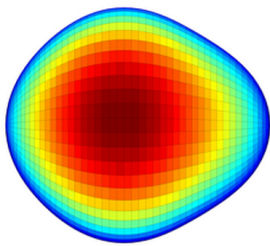9 May 2013
Pear-shaped atoms may hold clues to unsolved physics
by Will Parker
 Physicists have found the first direct evidence of exotic pear shaped nuclei in atoms, a discovery that could advance the search for a new fundamental force in nature and explain why the Big Bang created more matter than antimatter.
Physicists have found the first direct evidence of exotic pear shaped nuclei in atoms, a discovery that could advance the search for a new fundamental force in nature and explain why the Big Bang created more matter than antimatter.
The matter-anti-matter imbalance is one of physics' great mysteries. It's not predicted by the Standard Model, which describes four fundamental forces (or interactions) that govern how matter behaves: gravity attracts massive bodies to one another. The electromagnetic interaction gives rise to forces on electrically charged bodies. And the strong and weak forces operate in the cores of atoms, binding together neutrons and protons or causing them to decay.
But physicists suspect something is missing, and they've been searching for signs of a new force or interaction that might explain the matter-antimatter discrepancy. Now, the discovery that some atomic nuclei can assume asymmetric shapes with more mass at one end could shed much-needed light on the antimatter riddle.
Although physicists have speculated about the existence of pear-shaped nuclei, observing them directly has not been possible. Now, however, a new technique pioneered at the On-Line Isotope Mass Separator (ISOLDE) facility at CERN has been successfully used to study the shape of the short-lived isotopes Radon 220 and Radium 224.
The researchers say that the cores of these atoms are shaped like pears, rather than the more typical spherical orange or elliptical watermelon profiles. "The pear shape is special," said Tim Chupp, a University of Michigan professor of physics and co-author of a paper detailing the discovery in Nature. "It means the neutrons and protons, which compose the nucleus, are in slightly different places along an internal axis."
Chupp explains that the pear-shaped nuclei are lopsided because positive protons are pushed away from the center of the nucleus by nuclear forces, which are fundamentally different from spherically symmetric forces like gravity. "The new interaction, whose effects we are studying does two things," he said. "It produces the matter/antimatter asymmetry in the early universe and it aligns the direction of the spin and the charge axis in these pear-shaped nuclei."
To determine the shape of the nuclei, the researchers produced beams of the exotic radium and radon atoms. The beams were accelerated and smashed into targets of nickel, cadmium and tin, but due to the repulsive force between the positively charged nuclei, nuclear reactions were not possible. Instead, the nuclei were excited to higher energy levels, producing gamma rays that flew out in a specific pattern that revealed the pear shape of the nucleus.
Research leader Peter Butler, from the University of Liverpool, said the findings will help inform current searches for atomic electric dipole moments (EDMs) currently being carried out in North America and Europe, where new techniques are being developed to exploit the special properties of radon and radium isotopes.
"Our expectation is that the data from our nuclear physics experiments can be combined with the results from atomic trapping experiments measuring EDMs to make the most stringent tests of the Standard Model, the best theory we have for understanding the nature of the building blocks of the universe," Butler concluded.
Related:
Discuss this article in our forum
Antimatter bottled-up for 16 minutes
New experimental findings challenge theory of electromagnetism
Atom shadow photographed using traditional microscopy
Fine structure constant may vary across universe
Source: University of Michigan
